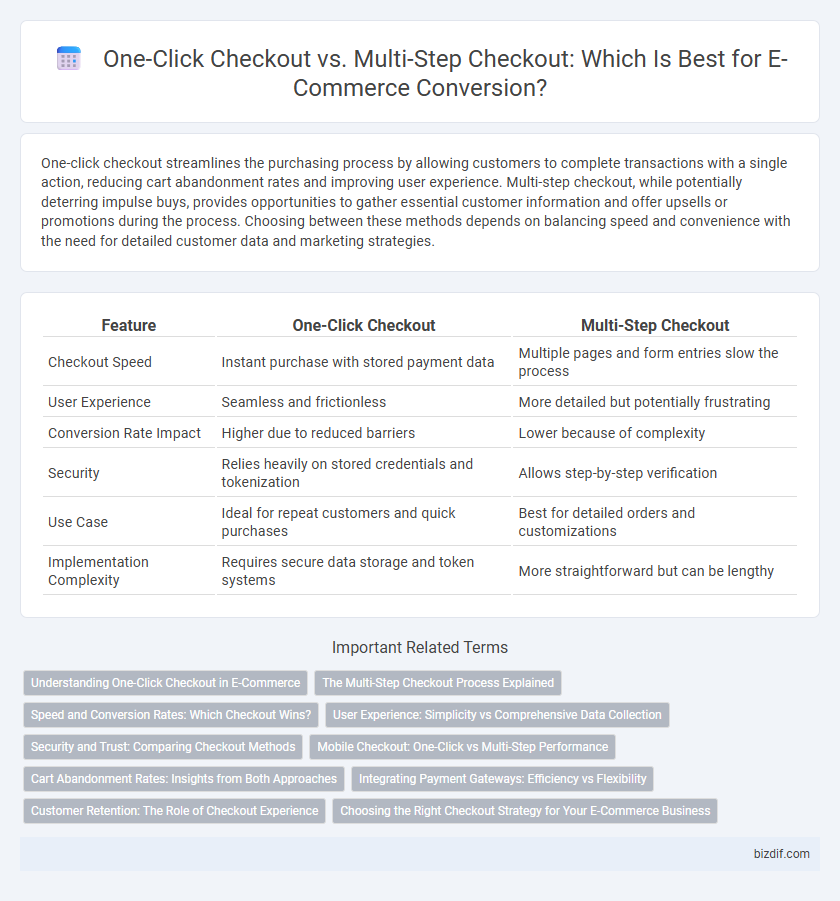One-click checkout streamlines the purchasing process by allowing customers to complete transactions with a single action, reducing cart abandonment rates and improving user experience. Multi-step checkout, while potentially deterring impulse buys, provides opportunities to gather essential customer information and offer upsells or promotions during the process. Choosing between these methods depends on balancing speed and convenience with the need for detailed customer data and marketing strategies.
Table of Comparison
| Feature | One-Click Checkout | Multi-Step Checkout |
|---|---|---|
| Checkout Speed | Instant purchase with stored payment data | Multiple pages and form entries slow the process |
| User Experience | Seamless and frictionless | More detailed but potentially frustrating |
| Conversion Rate Impact | Higher due to reduced barriers | Lower because of complexity |
| Security | Relies heavily on stored credentials and tokenization | Allows step-by-step verification |
| Use Case | Ideal for repeat customers and quick purchases | Best for detailed orders and customizations |
| Implementation Complexity | Requires secure data storage and token systems | More straightforward but can be lengthy |
Understanding One-Click Checkout in E-Commerce
One-click checkout in e-commerce streamlines the purchasing process by allowing customers to complete transactions with a single click, utilizing pre-saved payment and shipping information. This method significantly reduces cart abandonment rates by minimizing steps and simplifying user experience. Implementing one-click checkout can boost conversion rates and customer satisfaction through faster, more convenient transactions.
The Multi-Step Checkout Process Explained
The multi-step checkout process breaks down the purchasing journey into several distinct stages, such as shipping information, payment details, and order review, which helps reduce user errors and enhances data accuracy. By guiding customers through a structured flow, it increases clarity, making complex orders easier to manage and reducing cart abandonment rates for more involved transactions. This method is especially beneficial for stores requiring extensive input or upselling opportunities at various points throughout the checkout.
Speed and Conversion Rates: Which Checkout Wins?
One-click checkout significantly improves speed by enabling customers to complete purchases with a single action, reducing friction and cart abandonment rates. Multi-step checkout, while providing detailed order review and customization options, often leads to slower transaction times and higher dropout rates due to complexity. Research shows one-click checkout can boost conversion rates by up to 30%, making it the preferred choice for maximizing sales efficiency in e-commerce.
User Experience: Simplicity vs Comprehensive Data Collection
One-click checkout enhances user experience by streamlining the purchase process, minimizing friction and reducing cart abandonment rates through simplicity. Multi-step checkout offers comprehensive data collection at each stage, allowing for tailored promotions and fraud prevention but can introduce friction and increase drop-off rates. Balancing speed with necessary data capture is crucial for optimizing conversion rates and customer satisfaction in e-commerce.
Security and Trust: Comparing Checkout Methods
One-click checkout streamlines the payment process by storing customer data securely, reducing the risk of input errors and cart abandonment while employing advanced encryption technologies to protect sensitive information. Multi-step checkout, though more time-consuming, enhances trust by clearly presenting each step and verifying customer details, which can reduce fraudulent transactions through added authentication layers. Both methods prioritize security, but one-click checkout leverages convenience with robust protection, whereas multi-step checkout emphasizes transparency and control to build customer confidence.
Mobile Checkout: One-Click vs Multi-Step Performance
One-click checkout significantly reduces friction in mobile shopping by streamlining the payment process to a single action, leading to higher conversion rates and lower cart abandonment. Multi-step checkout, while providing more detailed options and information, often causes mobile users to drop off due to longer load times and complex navigation. Optimizing for one-click checkout on mobile devices improves user experience and accelerates the purchasing journey, which is critical for maximizing sales in e-commerce.
Cart Abandonment Rates: Insights from Both Approaches
One-click checkout significantly reduces cart abandonment rates by streamlining the purchase process into a single, frictionless action, enhancing user convenience and boosting conversion rates. Multi-step checkout, while providing opportunities for upselling and gathering customer information, often experiences higher abandonment due to longer engagement and increased chances for users to encounter friction points. Data from leading e-commerce platforms shows that simplifying checkout with one-click options can decrease abandonment by up to 30%, emphasizing the critical impact of user experience design on final sales.
Integrating Payment Gateways: Efficiency vs Flexibility
Integrating payment gateways in one-click checkout systems significantly enhances efficiency by enabling instant transactions with minimal user input, reducing cart abandonment rates. Multi-step checkout processes offer greater flexibility, allowing customers to choose from various payment methods and options, which can be crucial for international or diverse customer bases. Balancing the need for speed and customization is essential for e-commerce platforms aiming to optimize user experience and maximize conversion rates.
Customer Retention: The Role of Checkout Experience
One-click checkout significantly enhances customer retention by streamlining the purchasing process, reducing friction, and minimizing cart abandonment rates, which aligns with consumer preferences for convenience and speed. Multi-step checkout, while providing opportunities for upselling and detailed data collection, often leads to higher drop-off rates due to its complexity and time consumption. Optimizing checkout experience by prioritizing simplicity and efficiency directly influences repeat purchase behavior and long-term customer loyalty in e-commerce.
Choosing the Right Checkout Strategy for Your E-Commerce Business
Selecting the optimal checkout strategy hinges on analyzing your e-commerce business's customer behavior and product complexity; one-click checkout accelerates transactions by reducing cart abandonment rates, especially for repeat customers. Multi-step checkout, while potentially lengthier, can enhance security perception and collect detailed information useful for high-value or customizable products. Balancing convenience with trust ensures the checkout process aligns with your target audience's expectations and sales objectives.
One-Click Checkout vs Multi-Step Checkout Infographic

 bizdif.com
bizdif.com